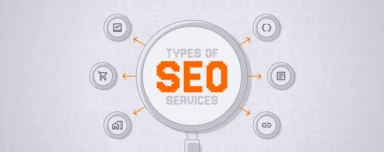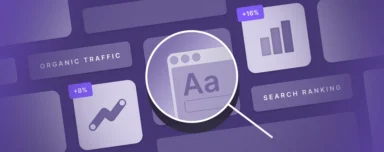The Complete Guide to Different Keyword Types
Did you know the average website only ranks for about 3-5% of the keywords it could potentially target? That’s because most people approach keywords like they’re all the same. They pick a few terms, sprinkle them into their content, and hope for the best.
Truth is, there’re actually several different types of keywords. Try to use them all the same way, and you’ll keep struggling. Learn to properly use each type, and you’ll finally start seeing real results.
Why Do Keywords Matter?
Let’s start with the basics. Keywords are the words and phrases people type into search engines when they’re looking for something. It could be “best pizza near me,” “how to change a tire,” or just “weather.” In fact, anything someone searches for is technically a keyword.
When you use the right keywords in your content, you’re essentially telling Google, “Hey, this page is exactly what people are searching for.” Google then uses this information to decide whether your page deserves to show up when someone searches for those terms.
Why Google Cares About Keywords (And Why You Should Too)
Google’s mission is to deliver the most helpful, relevant results as quickly as possible. Keywords are one of the primary ways it can figure out what your content is about and whether it matches what someone is looking for.
When search engines crawl your website, they’re essentially reading your content and looking for signals about your topic and expertise. This includes things like:
- What your page is about
- Who might find it useful
- How it compares to other pages on the same topic
- Whether you’re an authority on the subject
How Many Types of Keywords Are There in SEO?
Now here’s where things get more complex. There isn’t just one way to categorize keywords. And depending on what you’re trying to accomplish, you can look at keywords through several different lenses:
- By length: Short-tail vs. long-tail keywords
- By search intent: What the person is trying to accomplish
- By function: How they’re used in your content strategy
- By competition level: How hard they are to rank for
Each way of categorizing keywords serves a different purpose in your SEO strategy. Let’s get into each type so you can understand when and how to use them.
Types of Keywords by Length
Short-Tail Keywords
Short-tail keywords are the brief, usually 1-2 word phrases that cover broad topics. Think “shoes,” “marketing,” or “recipes.” These keywords typically have high search volume but are incredibly competitive and often lack specific intent.
Examples:
- “pizza”
- “insurance”
- “fitness”
- “travel”
Pros:
- High search volume
- Broad reach
- Good for brand awareness
Cons:
- Extremely competitive
- Vague search intent
- Lower conversion rates
Long-Tail Keywords
Long-tail keywords are longer, more specific phrases (usually 3+ words) that target niche topics. While they have lower search volume individually, they often convert better because they target people with specific needs.
Examples:
- “best gluten-free pizza delivery in Chicago”
- “small business liability insurance cost”
- “beginner yoga poses for back pain”
- “family-friendly hotels in Paris with pools”
Pros:
- Less competition
- Higher conversion rates
- More specific targeting
- Easier to rank for
Cons:
- Lower individual search volume
- Need more keywords to drive significant traffic
Want to learn more? See these strategies in action with our guide to long-tail vs short-tail keywords. You’ll learn exactly which keywords to target first for faster results.
Types of Keywords by Search Intent
Understanding why someone is searching is just as important as knowing what they’re searching for. Search intent helps you create content that matches what people actually want to find.
Informational Keywords
These are used when people want to learn something or find information. They’re often question-based or start with words like “how,” “what,” “why,” or “when.”
Examples:
- “how to change a car tire”
- “what is compound interest”
- “symptoms of food poisoning”
- “history of jazz music”
Best for: Blog posts, guides, tutorials, and other long form content.
Transactional Keywords
People use these when they’re ready to buy, sign up, or take a specific action. These keywords often include words like “buy,” “purchase,” “order,” “download,” or “subscribe.”
Examples:
- “buy iPhone 15 online”
- “order pizza delivery”
- “download free budget template”
- “subscribe to Netflix”
Best for: Product pages, service pages, landing pages, checkout pages
Navigational Keywords
These are used when people are looking for a specific website or page. They usually include brand names or specific destinations.
Examples:
- “Facebook login”
- “Amazon customer service”
- “Nike official website”
- “Gmail inbox”
Best for: Homepage optimization, brand pages
Commercial Keywords
These sit between informational and transactional. People are researching with the intent to buy soon. They’re comparing options, reading reviews, or looking for the best deals.
Examples:
- “best laptop for college students”
- “top-rated restaurants downtown”
- “cheapest car insurance companies”
If you’re wondering how this looks in practice, we’ve got a whole breakdown on navigational, commercial, informational and transactional keywords that covers real implementation strategies you can use.
Types of Keywords by Function
Primary Keywords
Your primary keyword is the main focus of a piece of content – the one term you most want to rank for. Each page should have one primary keyword that guides the content creation.
How to use them:
- Include in your title tag
- Use in your H1 heading
- Mention naturally throughout your content
- Include in your meta description
Secondary Keywords
These are related terms that support your primary keyword. They help Google understand the full context of your content and can help you rank for multiple related searches.
Examples: If your primary keyword is “home office setup,” secondary keywords might include:
- “work from home desk”
- “ergonomic office chair”
- “home office lighting”
- “productivity workspace”
LSI (Latent Semantic Indexing) Keywords
LSI keywords are terms that are conceptually related to your main keyword. They help search engines understand the context and meaning of your content.
Examples: For a page about “apple pie recipe,” LSI keywords might include:
“baking”
“dessert”
“cinnamon”
“pastry”
“oven temperature”
Branded Keywords
These include your company name, product names, or other brand-specific terms. They’re important for protecting your brand presence in search results.
Examples:
- “Nike Air Jordan”
- “Tesla Model 3”
- “Starbucks near me”
- “Apple iPhone support”
Local Keywords
If you serve customers in specific geographic areas, local keywords help you show up for location-based searches.
Examples:
- “dentist in Austin Texas”
- “pizza delivery downtown Seattle”
- “plumber near me”
- “Chicago wedding photographer”
Types of Keywords by Competition
High-Competition Keywords
These are the keywords everyone wants to rank for. They typically have high search volume but are dominated by established websites with strong domain authority.
Characteristics:
- Very high search volume
- Dominated by big brands or authority sites
- Often shorter, more generic terms
- Can take years to rank for
Examples:
- “insurance”
- “credit cards”
- “fitness”
- “travel”
Medium-Competition Keywords
These keywords have decent search volume but aren’t quite as saturated. They often represent good opportunities for established websites to target.
Characteristics:
- Moderate search volume
- Mix of established and newer sites ranking
- Often include some specificity
- Achievable with consistent effort
Examples:
- “small business insurance”
- “travel credit cards”
- “home fitness equipment”
- “budget travel tips”
Low-Competition Keywords
These are often longer, more specific phrases with lower search volume but also lower competition. They’re great starting points for newer websites.
Characteristics:
- Lower search volume
- Less established competition
- Often very specific or niche
- Faster to rank for
Examples:
- “small business insurance for food trucks in California”
- “travel credit cards with no foreign transaction fees”
- “home fitness equipment for small apartments”
- “budget travel tips for college students in Europe”
How to Choose the Right Keywords for Your Site
With all these different types of keywords, how do you decide which ones to focus on? Here’s a practical approach:
Start with Your Goals
Are you trying to:
- Drive immediate sales? Focus on transactional keywords
- Build brand awareness? Mix in some higher-volume terms
- Establish expertise? Create content around informational keywords
- Compete locally? Prioritize local keywords
Consider Your Website’s Authority
New websites should focus on:
- Long-tail keywords
- Low-competition terms
- Local keywords (if applicable)
- Informational content to build authority
Established websites can target:
- A mix of short-tail and long-tail keywords
- Medium to high-competition terms
- Broader topic coverage
- More competitive transactional keywords
Think About User Intent
Make sure your content matches what searchers actually want. If someone searches “best running shoes,” they probably want reviews and recommendations, not a page trying to sell them shoes immediately.
Helpful Tools for Keyword Research
To effectively research and categorize keywords, you’ll want to use some tools:
Free Options:
- Google Keyword Planner
- Google Trends
- Google Search Console
- Answer the Public
Paid Options:
- SEMrush
- Ahrefs
- Moz Keyword Explorer
- KWFinder
These tools can help you:
- Find new keyword opportunities
- Understand search volume and competition
- Identify user intent
- Track your rankings over time
Common Mistakes You’ll Want to Avoid
Keyword Stuffing
Don’t cram keywords unnaturally into your content. Google is smart enough to recognize this, and it hurts both your rankings and user experience.
- Bad: “Our Chicago pizza restaurant serves the best Chicago pizza in Chicago. If you want Chicago pizza, our Chicago pizza restaurant is the best Chicago pizza place.”
- Good: “Our Chicago restaurant serves authentic deep-dish pizza made with locally-sourced ingredients. We’ve been perfecting our recipes for over 20 years.”
Ignoring Search Intent
Don’t just target high-volume keywords without considering what your users actually want. A mismatch between your content and search intent will result in high bounce rates and poor rankings.
Forgetting About High-level Informational Searches
Many businesses get caught up chasing high-volume, competitive keywords and ignore the easier wins available with long-tail terms.
Not Considering the Full Customer Journey
Your keyword strategy should cover all stages of the buyer’s journey, from initial awareness (informational keywords) to final purchase (transactional keywords).
Putting It All Together
Here’s how to build a comprehensive keyword strategy using all these different types:
1. Map Keywords to Content Types
- Informational keywords → Blog posts, guides, tutorials
- Transactional keywords → Product/service pages, landing pages
- Commercial investigation → Comparison pages, reviews
- Navigational keywords → Homepage, about page, contact page
2. Create a Keyword Hierarchy
- Primary keywords: The main focus of each page
- Secondary keywords: Supporting terms that add context
- LSI keywords: Related terms that help Google understand your content
3. Balance Competition Levels
- 10-20% low-competition: Steady, achievable wins
- 20-70% medium-competition: Growth opportunities
- 70-90% high-competition: Long-term ambitious goals
4. Plan for the Long Term
Keyword strategy isn’t a one-time thing.
- Regularly research new keyword opportunities
- Monitor your rankings and adjust strategy
- Update content as search trends change
- Expand into new keyword territories as your authority grows
Before You Go, Just Remember…
Keywords are just one piece of the puzzle. The best keyword strategy in the world won’t help if your content isn’t genuinely useful, your website is slow, or your user experience is poor. Focus on creating valuable content that naturally incorporates the right keywords for your audience and business goals. When you combine solid keyword research with great content, that’s when you’ll start seeing real results in the search rankings.
The key is to start where you are, use what you have, and gradually build your keyword strategy over time. Begin with the low-hanging fruit (long-tail, low-competition keywords), establish your authority, and then gradually work your way up to more competitive terms. SEO is a marathon, not a sprint.






